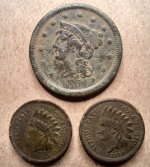If I asked this question before, I apologize, and plead advanced senility. 
I have long wondered just what the supply of gold in Mexico looked like 500 years ago. Today, gold is awfully hard to find, and that seems to be true in most countries as well.
But, was it that hard to find 500 years ago? The alleged treasure of Moctezuma was estimated to be as much as 20 tons of gold and jewels. Thinking in today's terms, that would have been an unbearable burden to find and dig up that much stuff. But, assume with me that before every square inch was searched, there might have been a lot of it easily obtained.
The Aztecs had a tremendous labor pool. Not only were there great numbers of slaves. But, also the Tenochas would send out orders to the conquered tribes how much stuff was to be delivered as tribute every 80 days. Slaves; perfumes; miscellaneous. How the conquered tribes got the goodies was their problem. So, if gold were originally very plentiful, they could have decreed each tribe bring, oh, say, 10 pounds of gold each month. Remember this is a theoretical brain storm, not an evidence based theory.
In the early days of the Gold Rush in the US, at times a lucky prospector would find hundreds of thousands of dollars of gold in a very short time, and in a small place. And, almost immediately, other people would dig beside and around and under the lode. And, in short time the easy gold would be gone, though sometimes more difficult mining processes would bring up more gold, but at greater expense. Today, I think they go down thousands of feet.
That is what I am wondering happened when the Tenochas first started collecting gold. A lot of it in a hurry, then small quantities trickling in. So, more than one Emperor could have had a large treasure, and both theories, local burial, and long range transport to the north, could be correct.
Remember, this posting is pure conjecture. No supporting evidence exists as far as I know.
And, this does bring up a secondary question. Are there really large areas of the planet which have never had a human set foot on them? Maybe. Maybe not.
When some of you are out there in the wilderness of New Mexico or Arizona, it must be easy to imagine you are going where no man has gone before. Yet, the photos posted here at times show signs of human activity.

I have long wondered just what the supply of gold in Mexico looked like 500 years ago. Today, gold is awfully hard to find, and that seems to be true in most countries as well.
But, was it that hard to find 500 years ago? The alleged treasure of Moctezuma was estimated to be as much as 20 tons of gold and jewels. Thinking in today's terms, that would have been an unbearable burden to find and dig up that much stuff. But, assume with me that before every square inch was searched, there might have been a lot of it easily obtained.
The Aztecs had a tremendous labor pool. Not only were there great numbers of slaves. But, also the Tenochas would send out orders to the conquered tribes how much stuff was to be delivered as tribute every 80 days. Slaves; perfumes; miscellaneous. How the conquered tribes got the goodies was their problem. So, if gold were originally very plentiful, they could have decreed each tribe bring, oh, say, 10 pounds of gold each month. Remember this is a theoretical brain storm, not an evidence based theory.
In the early days of the Gold Rush in the US, at times a lucky prospector would find hundreds of thousands of dollars of gold in a very short time, and in a small place. And, almost immediately, other people would dig beside and around and under the lode. And, in short time the easy gold would be gone, though sometimes more difficult mining processes would bring up more gold, but at greater expense. Today, I think they go down thousands of feet.
That is what I am wondering happened when the Tenochas first started collecting gold. A lot of it in a hurry, then small quantities trickling in. So, more than one Emperor could have had a large treasure, and both theories, local burial, and long range transport to the north, could be correct.
Remember, this posting is pure conjecture. No supporting evidence exists as far as I know.
And, this does bring up a secondary question. Are there really large areas of the planet which have never had a human set foot on them? Maybe. Maybe not.
When some of you are out there in the wilderness of New Mexico or Arizona, it must be easy to imagine you are going where no man has gone before. Yet, the photos posted here at times show signs of human activity.









